Trial Objective
- Foliar fungicides are often used to help protect wheat (durum, spring, winter), barley, oats and triticale from ergot, fusarium head blight, leaf diseases and other diseases to help producers increase yield potential.
- The goal of this trial was to observe the impact of Prosaro® PRO fungicide compared to Miravis® Ace fungicide applied to wheat at the T3 growth stage on yield and moisture content at harvest.
- The optimum growth stage for Prosaro PRO application is when 75% of the spikelet on the main stem is emerged to when 50% of the spikelets are in flower. The optimum growth stage for Miravis® Ace fungicide is 50% head emergence to the flowering growth stage (Figure 1).
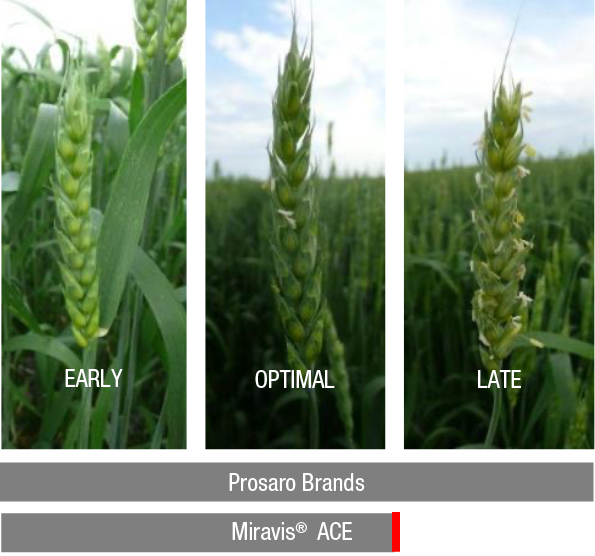 Figure 1. Application timing for Prosaro® brand fungicides and Miravis® Ace fungicide to wheat.
Figure 1. Application timing for Prosaro® brand fungicides and Miravis® Ace fungicide to wheat.
Experiment/Trial Design
Formulation, Rates and Packaging
- Prosaro® PRO fungicide contains three active ingredients from two different fungicide groups:
- Prothioconazole (Group 3) @ 150g ai/ha
- Tebuconazole (Group 3) @ 75g ai/ha
- Fluopyram (Group 7) @ 75g ai/ha
- The application rate for Prosaro PRO is 303 mL per acre, which covers 20 acres per jug.
- Prosaro PRO is a Suspension Concentrate (SC) formulation, and requires the addition of a Non-Ionic Surfactant (NIS) at 0.125% vol/vol.
- The application rate for Miravis® Ace fungicide is 404 mL per acre.
Trial Design
This trial was organized by Market Development Agronomists using the Demonstration Strip Trial format:
- Non-randomized replicated strip trial format.
- Treatments were applied with the cooperator's sprayer and each plot was as wide as the width of one pass of the cooperator’s sprayer.
- The strip plot format uses a scaled down treatment list.
- Some trials did not have an untreated check (UTC) due to the very high disease intensity.
- Leaf disease assessments were completed at application time as well as 14 days post application.
- Plots were harvested and yields were taken with weigh wagon or load weights on FieldView™.
- Samples sent to A&L Canada Laboratories for quality analysis.
- Data quality was assessed by evaluating the coefficient of variation (CV) for each of the yield and quality parameters. CV was assessed for the whole trial and for reps of each of the treatments. Only trials with a CV of less than 10 were used in data summaries.
 Figure 2. Disease damage ratings for the untreated check (UTC) on the day of application and approximately 14 days after application (DAA) at 9 locations of Bayer Crop Science trials in 2020.
Figure 2. Disease damage ratings for the untreated check (UTC) on the day of application and approximately 14 days after application (DAA) at 9 locations of Bayer Crop Science trials in 2020.
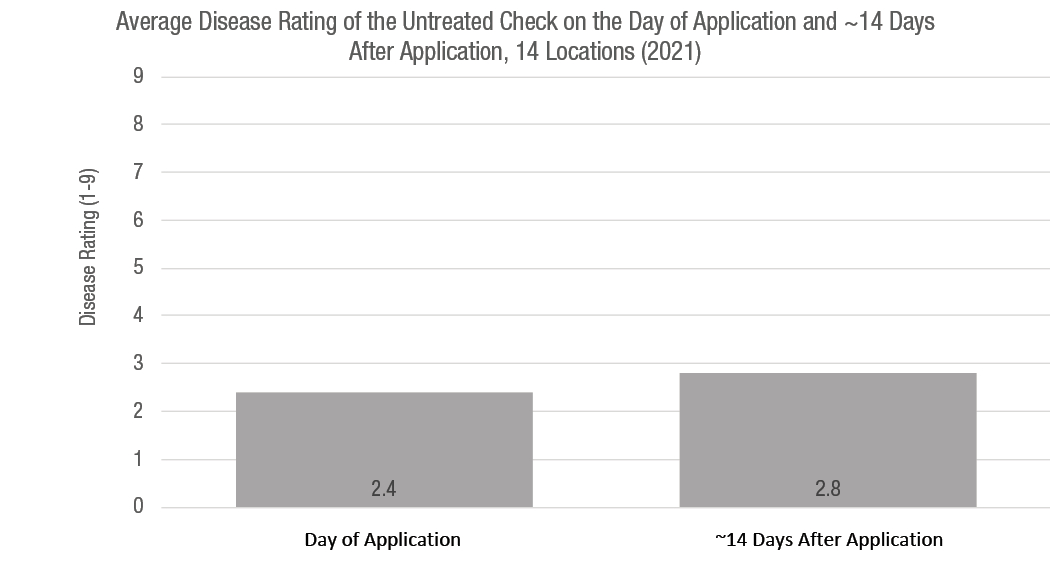 Figure 3. Disease damage ratings for the untreated check (UTC) on the day of application and approximately 14 days after application (DAA) at 14 locations of Bayer Crop Science trials in 2021.
Figure 3. Disease damage ratings for the untreated check (UTC) on the day of application and approximately 14 days after application (DAA) at 14 locations of Bayer Crop Science trials in 2021.
2020 Trial Locations
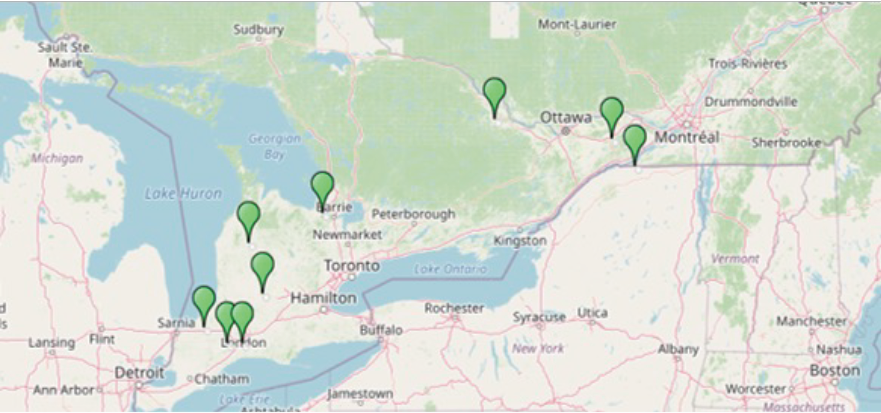 Figure 4. Trial locations in 2020.
Figure 4. Trial locations in 2020.
- Phelpston, Ont.
- Forest, Ont.
- Melborne, Ont.
- Mildmay, Ont.
- Glads Hill, Ont.
- Lambeth, Ont.
- Moose Creek, Ont.
- Douglas, Ont.
- Dundee, Ont.
2021 Trial Locations
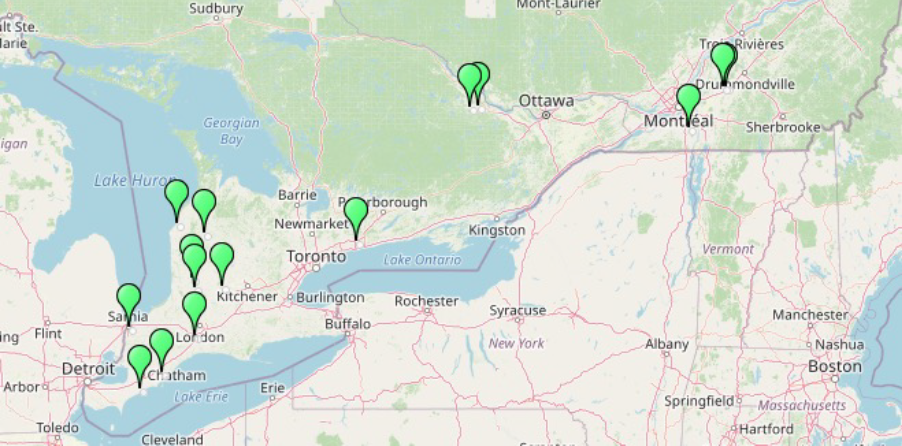 Figure 5. Trial locations in 2021.
Figure 5. Trial locations in 2021.
- Gad‘s Hill, Ont.
- Mildmay, Ont.
- Merlin, Ont.
- Sarnia, Ont.
- Ridgetown, Ont.
- London, Ont.
- Port Colborne, Ont.
- Staffa, Ont.
- Seaforth, Ont.
- Kincardine, Ont.
- Saint-Jacques-le-Mineur, Que.
- Saint-Simon Bagot, Que.
- Saint-Pie Bagot, Que.
- Hampton, Ont.
Understanding the Results
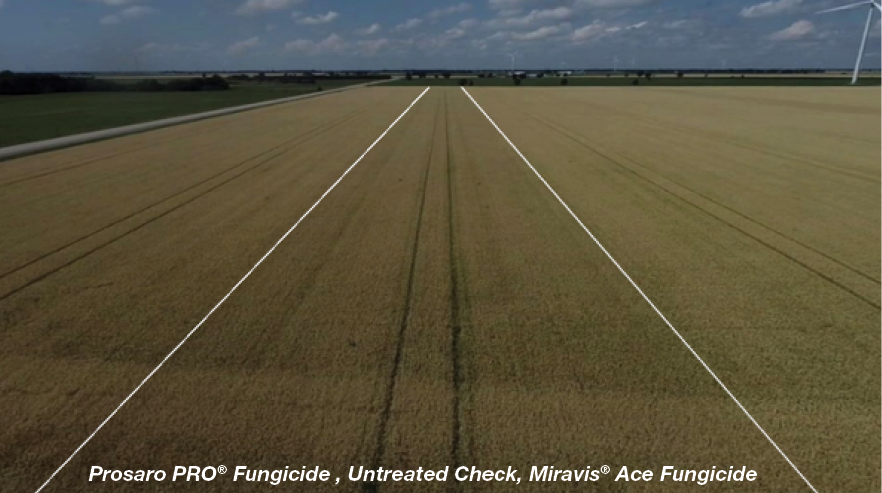 Figure 6. Drone image of trial in Merlin, Ontario in 2021. The image was taken two weeks prior to harvest.
Figure 6. Drone image of trial in Merlin, Ontario in 2021. The image was taken two weeks prior to harvest.
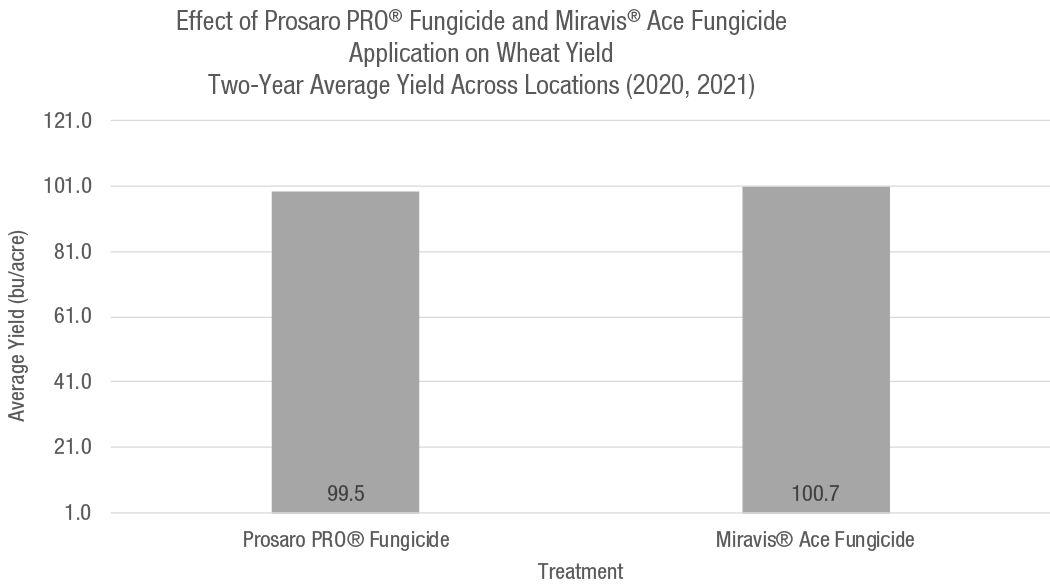 Figure 7. Average wheat yield of trials applied with Prosaro® PRO fungicide or Miravis® Ace fungicide at the T3 growth stage in 2020 and 2021. Yield corrected to 14% harvest moisture.
Figure 7. Average wheat yield of trials applied with Prosaro® PRO fungicide or Miravis® Ace fungicide at the T3 growth stage in 2020 and 2021. Yield corrected to 14% harvest moisture.
 Figure 8. Average harvest moisture of trials applied with Prosaro® PRO fungicide or Miravis® Ace fungicide at the T3 growth stage compared to an untreated check (UTC) in 2020 and 2021. Yield corrected to 14% harvest moisture.
Figure 8. Average harvest moisture of trials applied with Prosaro® PRO fungicide or Miravis® Ace fungicide at the T3 growth stage compared to an untreated check (UTC) in 2020 and 2021. Yield corrected to 14% harvest moisture.
Key Learning
Bayer Cereal Fungicide Trials 2020
- Precipitation was below normal for much of Ontario and substantially below normal in Quebec.
Bayer Cereal Fungicide Trials 2021
- Dry start to year did not make an environment conducive to disease infection.
- Low disease year for leaf disease and DON (vomitoxin) pressure.
- Differences in falling number were observed with treatments with delayed harvest. This was first observed in 2021. Further research is necessary to confirm these results and understand why. Falling number helps identify the structural integrity of the starch chains. A falling number between 275 - 320 is considered acceptable for flour baking quality and lower falling numbers are associated with weathering of the wheat caused by delayed harvest.
- Added moisture in Miravis® Ace fungicide can delay harvest for growers.
Multi-year summary
- In this study, wheat treated with Prosaro® PRO fungicide showed similar yields to wheat treated with Miravis® Ace fungicide.
- Across both years of this study, wheat treated with Prosaro PRO had a lower percent moisture at harvest than wheat treated with Miravis® Ace fungicide.
- Not enough DON pressure to make comments.
Legal Statements
Services and products offered by The Climate Corporation are subject to the customer agreeing to our Terms of Service. Our services provide estimates or recommendations based on models. These do not guarantee results. Before making financial, risk management and farming decisions, agronomists, commodities brokers and other service professionals should be consulted. More information at https://climatefieldview.ca/legal/disclaimer. FieldView™ is a registered trademark of The Climate Corporation. Used under license. ALWAYS READ AND FOLLOW PESTICIDE LABEL DIRECTIONS. Performance may vary from location to location and from year to year, as local growing, soil and weather conditions may vary. Growers should evaluate data from multiple locations and years whenever possible and should consider the impacts of these conditions on the grower’s fields.
Bayer, Bayer Cross and Prosaro® are registered trademarks of Bayer Group. Used under license. All other trademarks are the property of their respective owners. Bayer Crop Science Inc. is a member of CropLife Canada. ©2022 Bayer Group. All rights reserved. 1111_30551